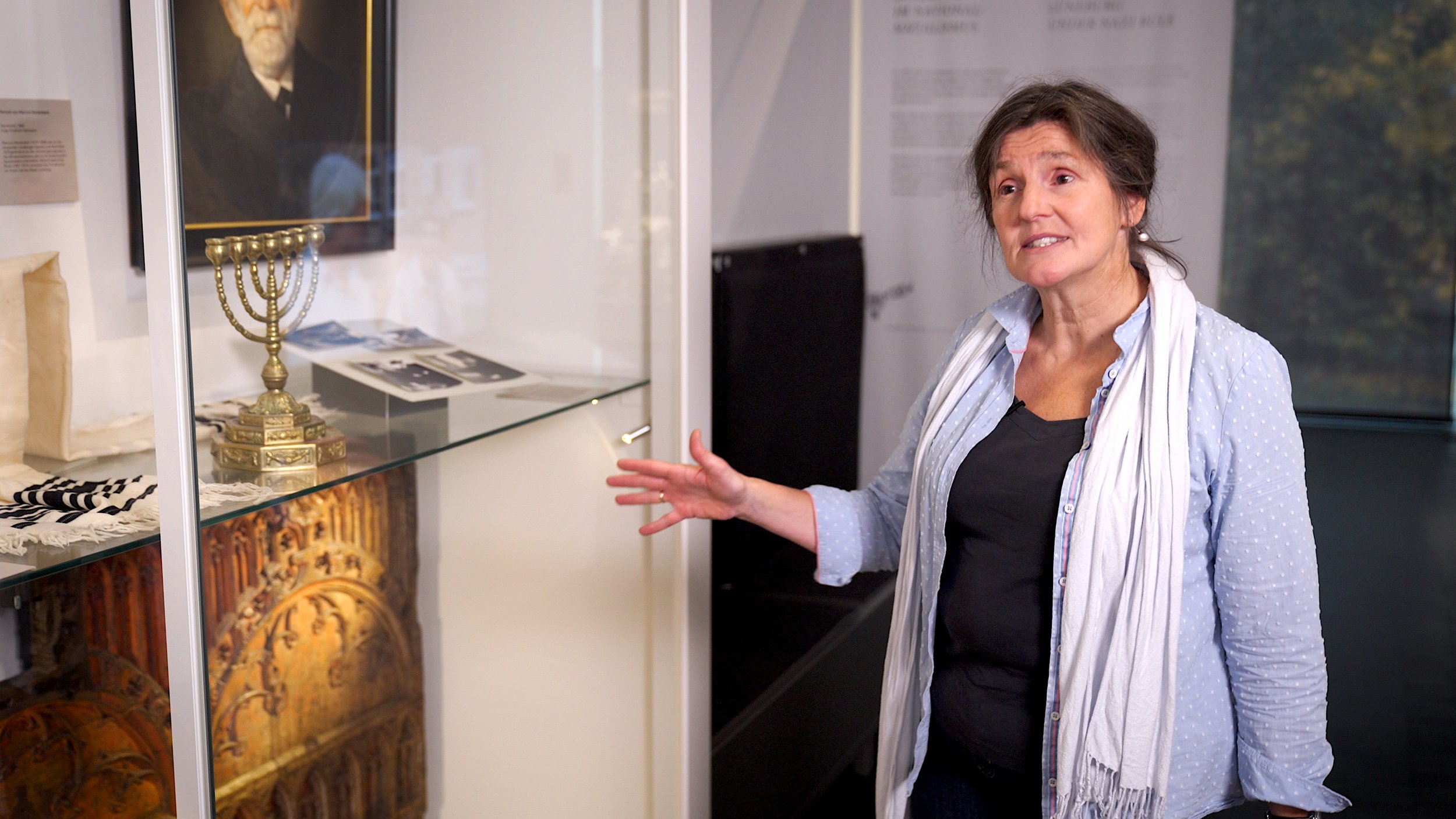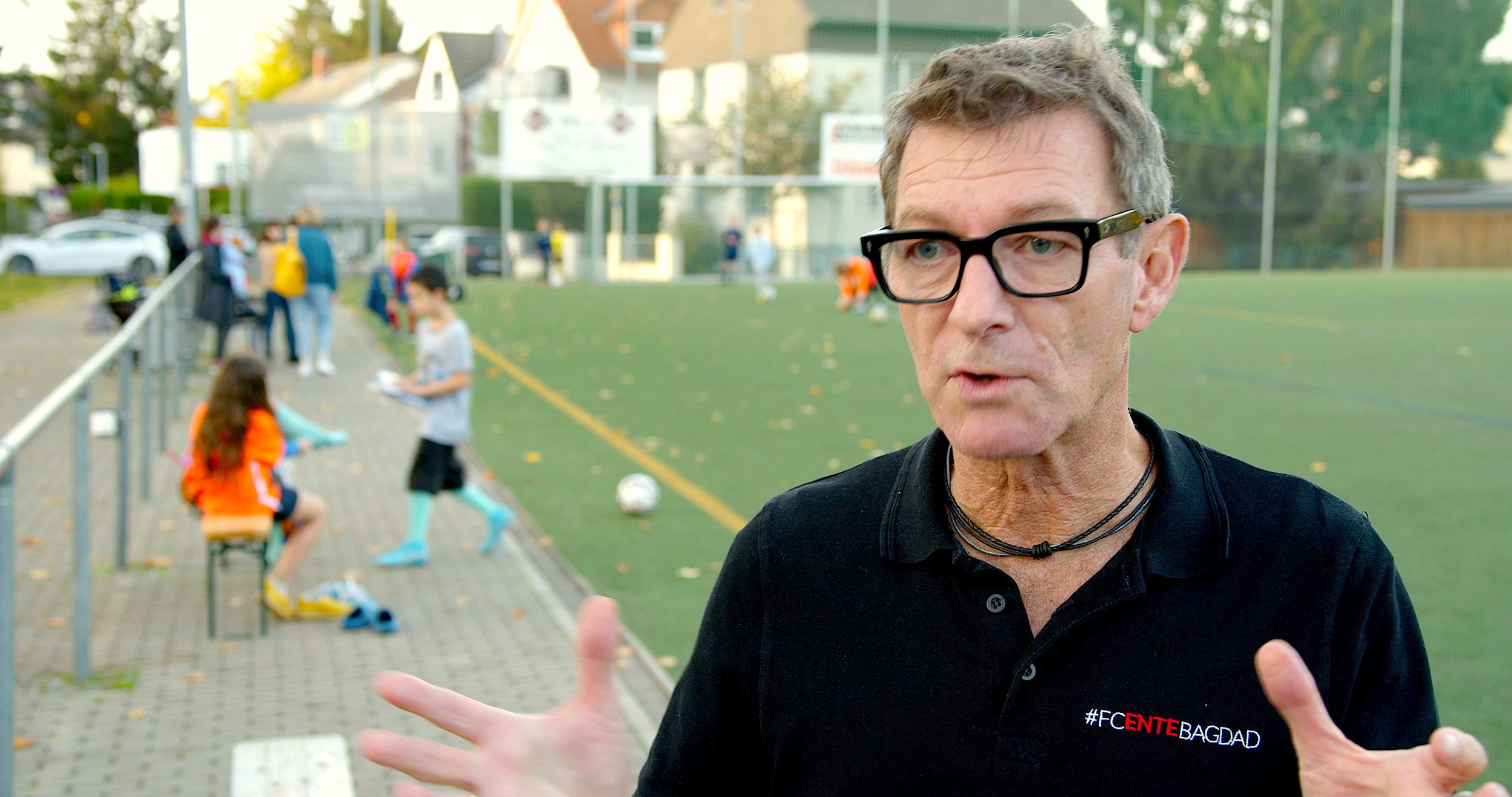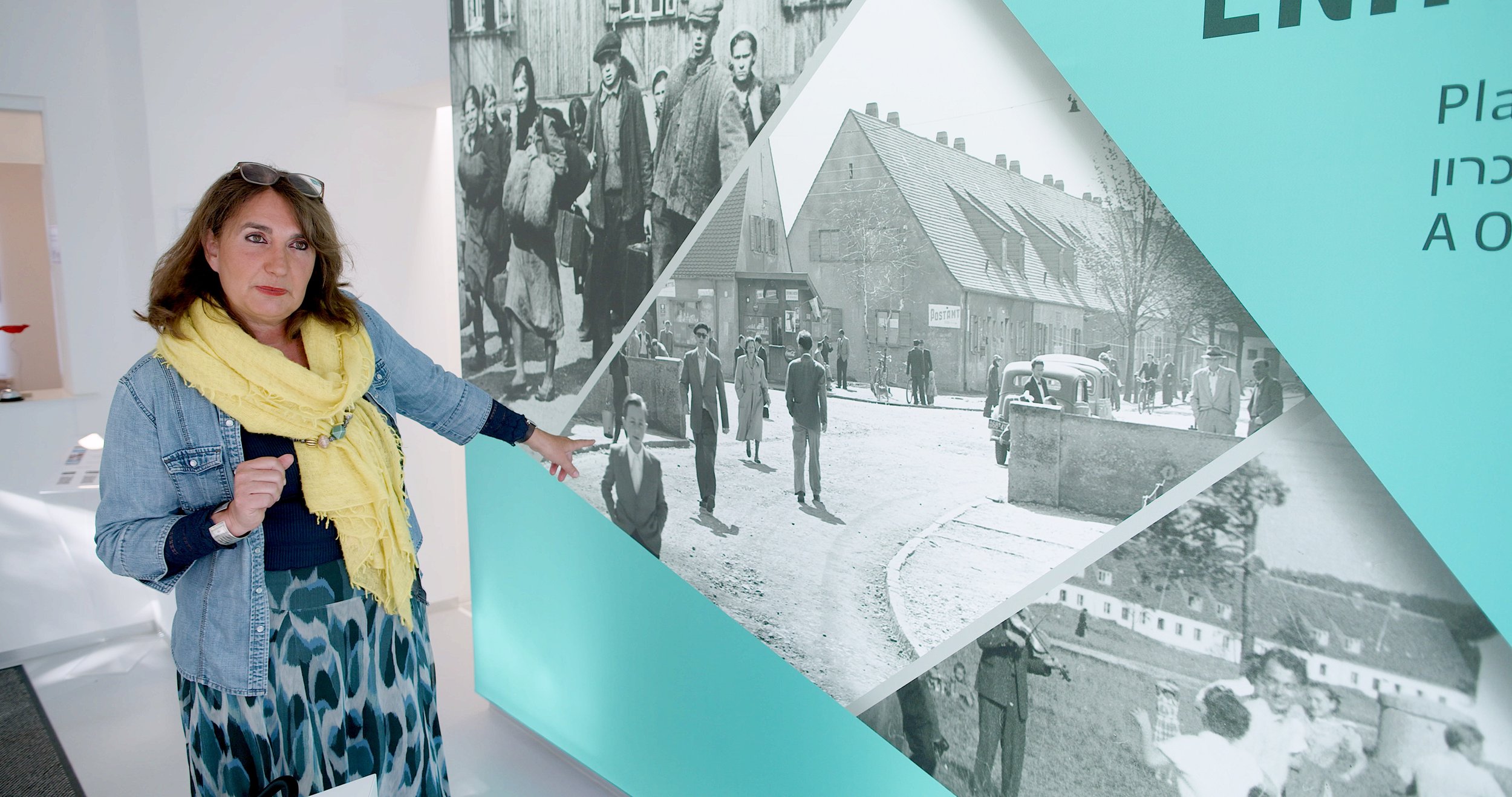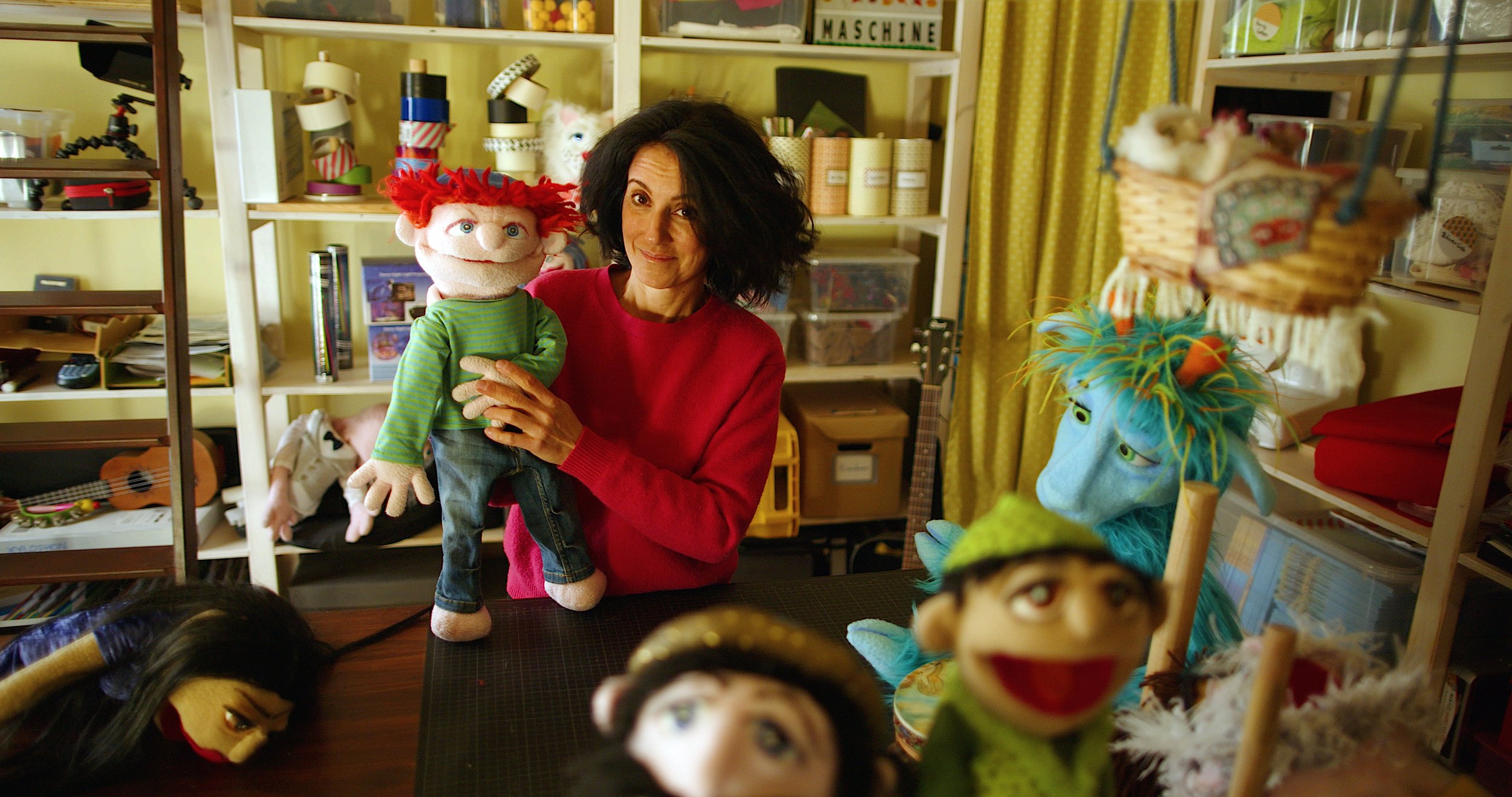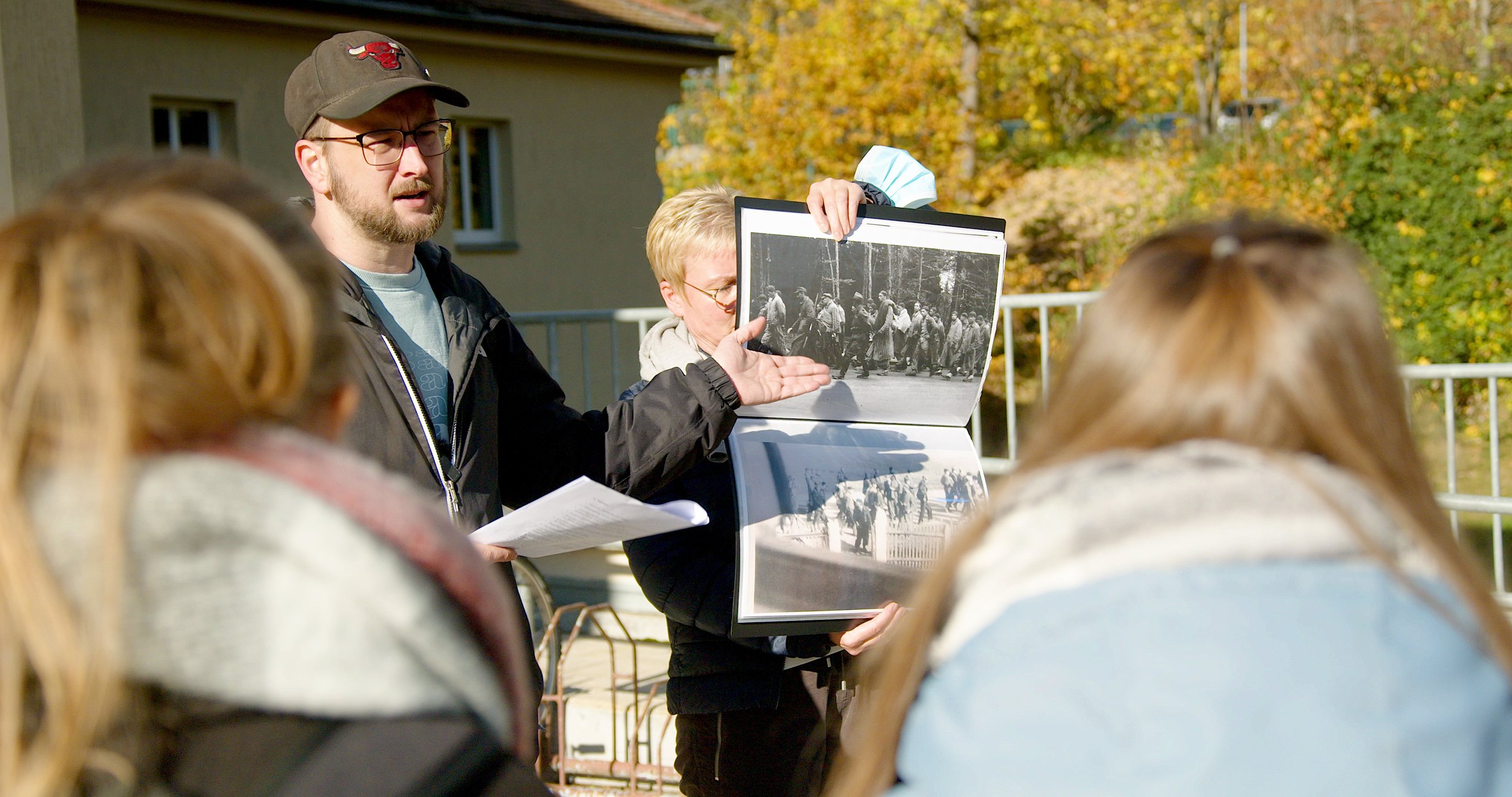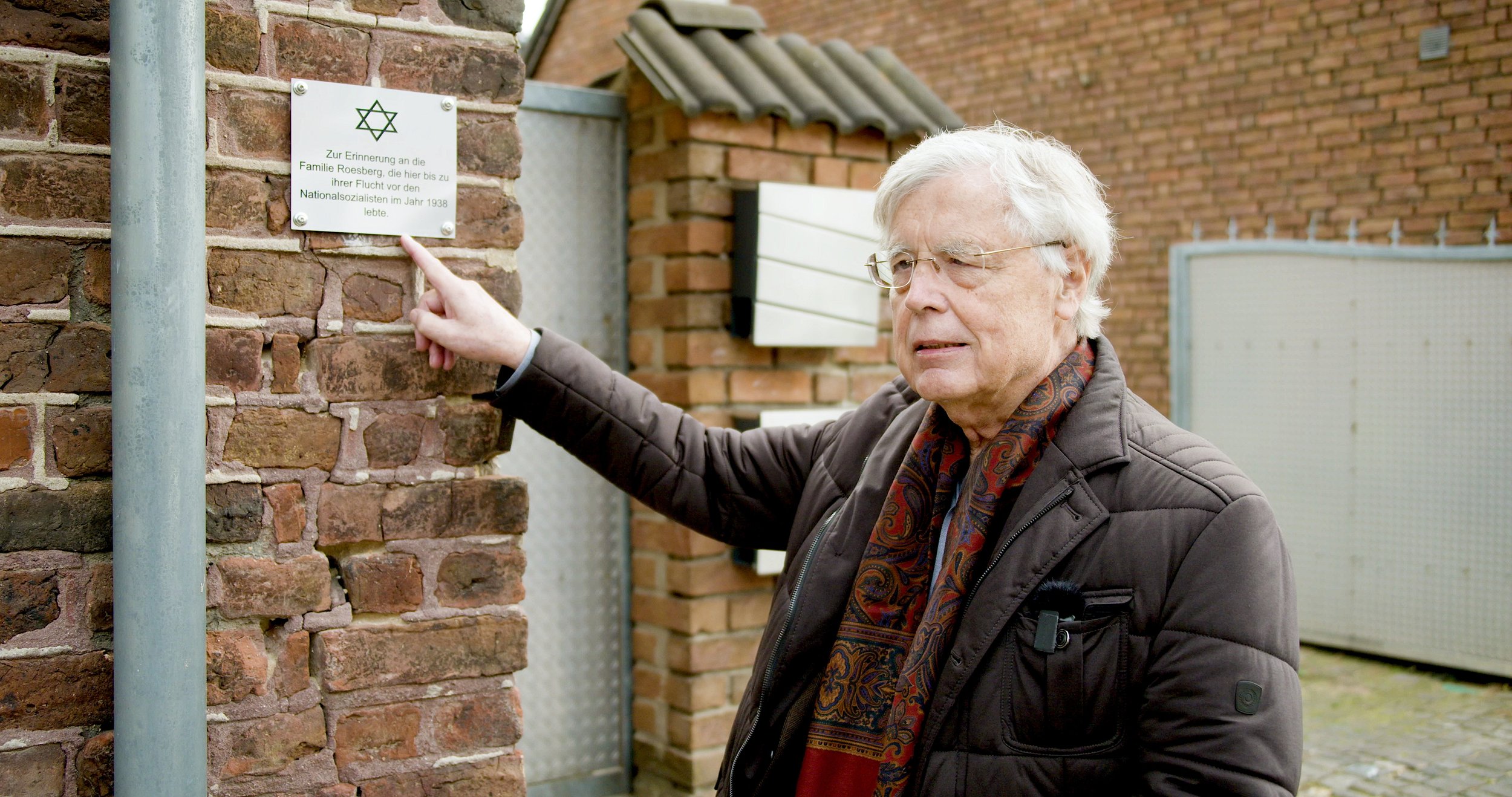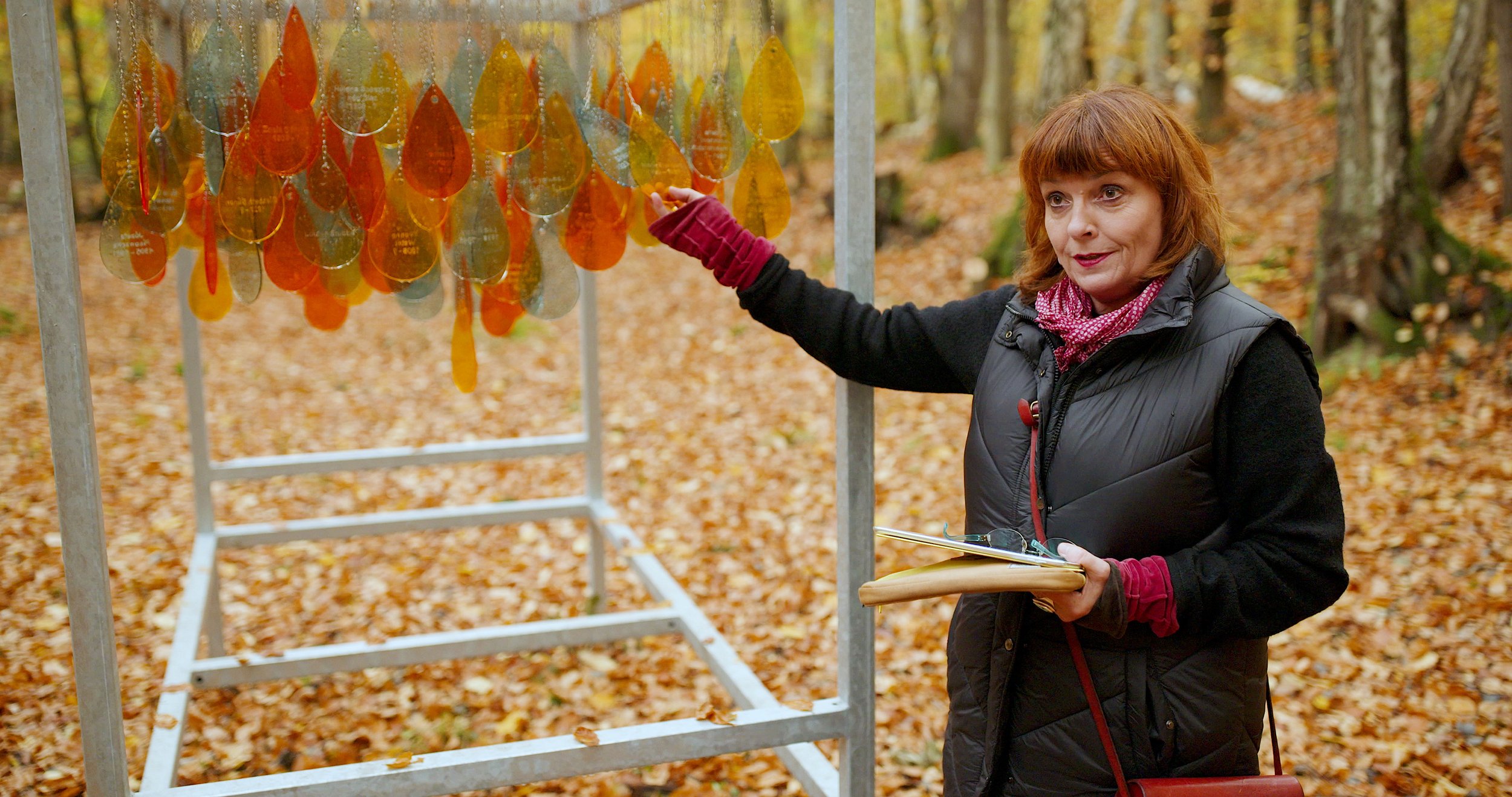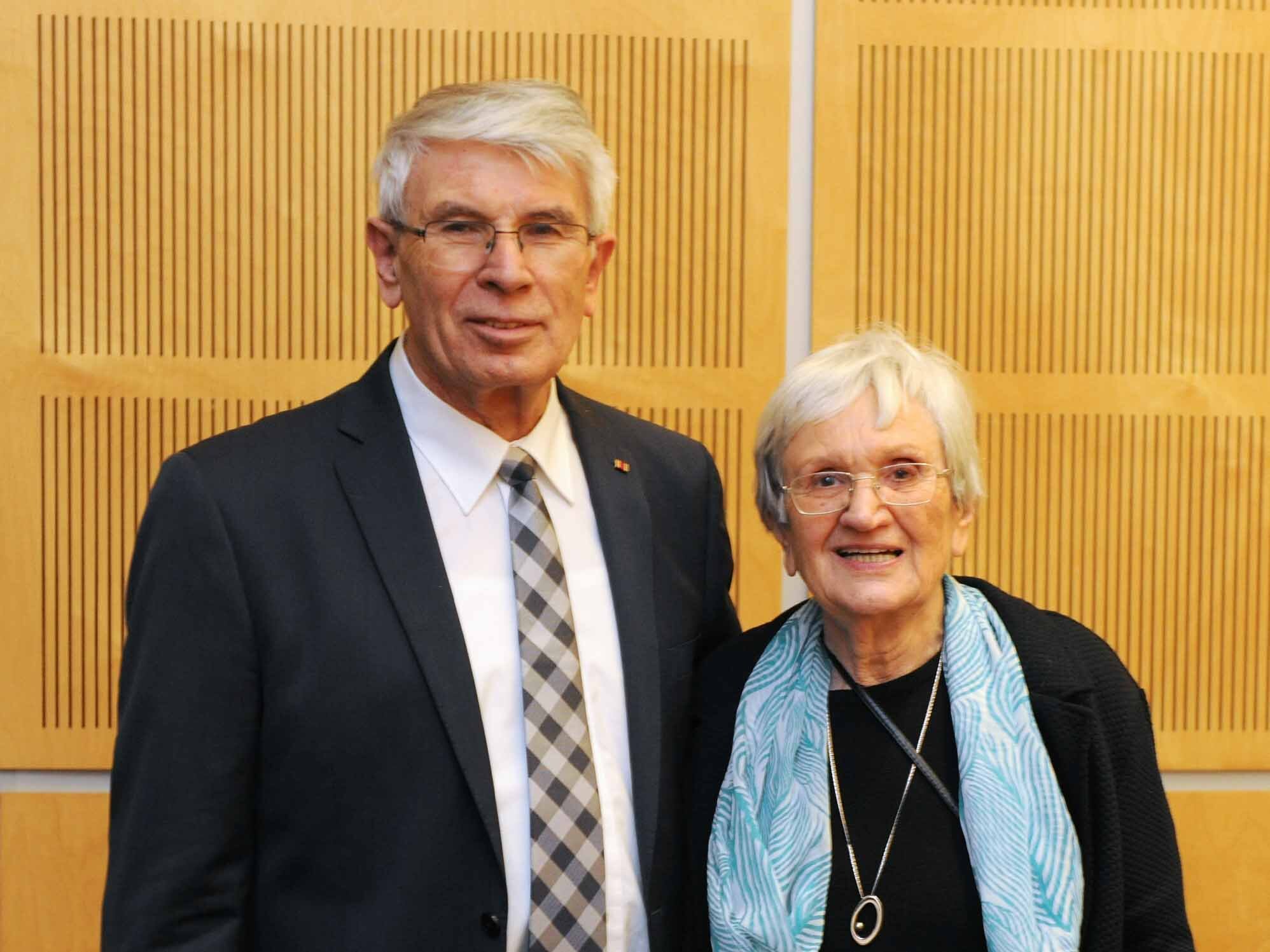Profiles
Obermayer Award Recipients 2024
A provenance researcher and historian, Anneke de Rudder researches objects looted by the Nazis, finding and contacting the rightful owners or their heirs. Many descendants have come to Germany, and she has introduced them to their ancestors’ hometowns. While the objects themselves often have little value, they bring the priceless gift of reuniting families and uncovering family history.
Teacher Dirk Erkelenz changed the culture of his high school in Cologne by training students to do research that commemorates Jews who attended the school and were victims of the Nazis. Their work of active remembrance has included locating, contacting, and developing relationships with descendants of the Jewish students. As a result, many of these descendants have visited Cologne. He has also coedited a book that incorporates his students’ research.
In 1997, a group of punk rockers took over two abandoned barracks of a former concentration camp. That group became Exil e.V., an organization with two main goals: to protect youth, migrants, and others from neo-Nazi violence, and to ensure that the history of the Nazi crimes not be forgotten. Exil has preserved the barracks, told the story of the forced laborers who had lived there, created a welcoming cultural life, and worked for sustainable change.
Christoph Mauny has brought a “living culture of remembrance” to Gotha. His creative and inspiring projects have included a unique 360-degree video installation at the site of the a former synagogue, now a shopping mall, and an ambitious digital “unfinished memorial” to 20,000 forced laborers at the Ohrdruf concentration camp. It features biographies, sketches, and more. Camp Ohrdruf, largely forgotten by locals, was the first camp liberated by the U.S. Army.
As an Afro-German historian, author, and community leader, Katharina Oguntoye has turned her own experience of being othered into powerful lessons about identity, pride, and mutual respect. She broke down barriers of awareness and shined a light on Afro-German history, empowering Afro-Germans to share their own stories. Among her many accomplishments, she coedited the groundbreaking book “Showing Our Colors,” and founded the intercultural association JOLIBA, which serves families from many cultural backgrounds.
Marie Roshoven, with her late mother, Jani Pietsch, founded Denk Mal am Ort (Think About This Place). Once a year, residents in Berlin, Hamburg, Munich, and Frankfurt open their homes to share stories about people who once lived their—Jews and others persecuted by the Nazis or members of the resistance. Descendants often travel to Germany to participate, and the program includes walking tours, exhibitions, and live music.
History teacher and biographer Margit Sachse has empowered a generation of students to find out about history on their own, through direct encounters with witnesses, survivors, scholars, and historical documents—not only in Darmstadt but also internationally. She has established partnerships with groups working with young people and artists in France, Greece, and other countries. Her goal is to help transmit democratic values and to continue the fight against all forms of discrimination.
Obermayer Award Recipients 2023
Teacher Jörg Friedrich set out to nurture democratic thinking in his high school students and teach them what intolerance can lead to. His creative approach, which includes letting students choose the projects, has resulted in a traveling exhibition on local Jewish history, a website on Jewish life in Nohfelden, a remembrance trail, hiking days focusing on Jewish history and culture, two films, an app, and teaching materials with components in braille and audio elements geared to those with learning disabilities.
Stefan Schirmer has been the guiding force behind making football club FC Ente Bagdad into a beacon for diversity, acceptance, and equality, as well is in helping people recognize and understand Jewish history and culture. The club organizes many popular remembrance events, particularly during Mainz Remembrance Weeks, and reaches out to “new Germans” from war-torn countries including Syria, Afghanistan, and Ukraine who have found refuge in Mainz. For one match, the entire team wore kippahs, in solidarity with a person who had recently been attacked.
Together, Rudolf and Marlies Walter have played a key role in bringing to light the history of Bad Kissingen’s Jewish community, starting with a meticulously researched presentation in 1988 that became a permanent town exhibit. They have continuously engaged in exhaustive research, and worked on several memorial projects. They have also served as the key contact for many survivors and descendants, helping to build a renewed connection between the town and these families.
Retired teacher Roswitha Weber spent her career helping children recognize and embrace their natural capacity for empathy, using it as a means to introduce Jewish history, culture, and even Nazi crimes to elementary-school-age students. Her curriculum, based in part on the book “I am a Star” by survivor Inge Auerbacher, is now being used by other teachers and schools in her district. It helps students apply the lessons of history to their own interactions and worldview.
Marion Welsch focuses on bringing people together as a key role of exposing Jewish German history. She organized a project bringing grandparents and their grandchildren from Israel to meet with grandparents and grandchildren in Germany. Her book “A Washing Machine in Haifa” chronicles the story of a Jewish family in her mother’s hometown who escaped to Israel, including their relationship with Germany after the war. She also played a key role in researching and organizing her town’s first Stolpersteine project.
Zweitzeugen e.V. (Secondary Witnesses) turns young people into “witnesses” by teaching them the life stories of Holocaust survivors. Zweitzeugen has worked with 37 survivors to date, gathering their stories in great depth and sharing them through multifaceted workshops and various media. The workshops help students as young as 10 develop empathy and an emotional connection with the survivors, as well a stronger perspective on prejudice and hate in the world today.
Obermayer Award Recipients 2022
Obermayer Award Recipients 2000 - 2021
Since 2001, AKuBiZ has acted as a counterweight to widespread right-wing ideology in Saxon Switzerland, an area of Saxony between Dresden and the Czech border.(Obermayer Award 2021)
An educator, historian, and writer who has now retired from his work as a teacher and school principal, Volker Keller is largely credited with creating a remembrance culture in Mannheim. (Obermayer Award 2021)
Elisabeth Kahn’s meticulously researched theater projects bring German-Jewish history to life with an authenticity that resonates with audiences and connects with the young people who stage them. (Obermayer Award 2021)
The Erich Zeigner House stands up for democratic values, works against anti-Semitism and right-wing hate, and provides students with a deep understanding of history and its importance in today’s world. (Obermayer Award 2021)
Friederike Fechner has radically changed perceptions of the contributions of Jewish residents of Straslund before the Nazi era and of their tragic fate during the Holocaust. (Obermayer Award 2021)
Dr. Marion Lilienthal, researcher, historian, writer, and teacher, has spent more than two decades pursuing creative projects relating to Jewish history and culture and working against anti-democratic influences. (Obermayer Award 2021)
Sabeth Schmidthals uses sensitivity and empathy to empower her students to fight hate and anti-Semitism. (Obermayer Award 2020)
The Network for Democratic Culture combats fear, hate, and prejudice with outreach and education. (Obermayer Award 2020)
A groundbreaking fan project working with the Hertha Berlin Soccer Club examines prejudice and anti-Semitism. (Obermayer Award 2020)
Geschichtomat project weeks give teens a deeper perspective on German Jewish history while teaching practical media skills. (Obermayer Award 2020)
Norbert Giovannini has devoted himself to understanding and resuscitating Heidelberg’s Jewish past. (Obermayer Award 2020)
Playwright Michael Batz explores Hamburg’s role during the Nazi era. (Obermayer Award 2020)
Roland Müller brings to life the Jewish history of a Polish city that once was part of Germany. (Obermayer Award 2020)
Karl-Heinz Nieren introduces students to a stark truth close to home. (Obermayer Award 2020)
Hilde Schramm has spent her adult life fighting racism and intolerance. And she doesn’t shy from her family history as the daughter of an infamous Nazi leader. (Obermayer Award 2019)
A good story can touch us. Hans-Dieter Graf, his wife Martina, and his sister Gabriele Hannah, write books and tell stories that shed a light on our shared history. (Obermayer Award 2019)
For Benigna Schönhagen, reviving a region’s Jewish heritage isn’t only about history; it’s connecting people to an important truth about society. (Obermayer Award 2019)
A meticulous and self-taught researcher, Elisabeth Böhrer's passion for Jewish history began when she led a tour. That, she says, sparked “the whole thing.” (Obermayer Award 2019)
Egon Krüger’s interest in Jewish history began as a boy growing up in the late 1940s on the Baltic Sea island of Rügen, where his father’s friend, a Jewish spa owner, would visit their home and tell stories about his survival under Nazi rule during World War II. (Obermayer Award 2019)
As a teacher and researcher in the Hesse town of Fulda, Michael Imhof has passionately dedicated the past three decades to educating young people and town residents about his region’s rich Jewish heritage. (Obermayer Award 2019)
When a handful of ninth graders from Berlin met Rolf Joseph in 2003, they were inspired by his harrowing tales of surviving the Holocaust. So inspired that they wrote a popular book about his life. Today the Joseph Group helps students educate each other on Jewish history. (Obermayer Award 2018)
Margot Friedländer’s autobiography details her struggles as a Jew hiding in Berlin during World War II. Now 96, she speaks powerfully about the events that shaped her life and their relevance today. (Obermayer Award 2018)
In 1983, Karl Britz, a primary school teacher and member of the town council of Bodersweier, was asked to help write a village history commemorating the town’s 1,100-year anniversary. (Obermayer Award 2018)
On the night of November 9, 1938, 3-year-old Horst Moog stood beside his mother and watched the beautiful synagogue of Hamm, on the Sieg River in Rhineland-Palatinate, burn to the ground during Kristallnacht. (Obermayer Award 2018)
In 1977, Brunhilde Stürmer began collecting old photographs of her village, Niederzissen; many historic houses there had been torn down, and she wanted to document how the town had once looked. (Obermayer Award 2018)
In 2001, secondary school teachers Harald Roth and Volker Mall attended a local exhibition showing World War II aerial photos of what was called a “work camp” between the villages of Hailfingen and Tailfingen, about 30 kilometers south of Stuttgart. (Obermayer Award 2018)
Thilo Figaj
A decade ago, the cosmetics manufacturer Thilo Figaj came across a post-World War II history book with a chapter about his Hessen town, Lorsch, and was shocked to discover it omitted mention of the town’s most infamous son: Heinz Jost, a top-ranking SS commander. (Obermayer Award 2017)
GröschlerHaus
Since its founding in 2014, GröschlerHaus: Zentrum für Jüdische Geschichte und Zeitgeschichte der Region Friesland/Wilhelmshaven (Gröschler House: Center for Jewish History and Contemporary History of the Friesland/Wilhelmshaven Region) has served as an informational center, event venue and meeting place for people rediscovering the Jewish heritage of Jever and the surrounding area in northwestern Germany. (Obermayer Award 2017)
Ina Lorenz and Jörg Berkemann
After more than 20 years of research and writing, professors Ina Lorenz and Jörg Berkemann published their crowning achievement: more than 5,000 pages long, the seven-volume Die Hamburger Juden im NS-Staat 1933 bis 1938/39 (Hamburg´s Jews in the NS State, 1933 to 1938/39) is a milestone in the history and understanding of Jewish life in Hamburg during the Nazi years. (Obermayer Award 2017)
Projekt Jüdisches Leben in Frankfurt
In its nearly four decades of work, the non-profit Projekt Jüdisches Leben in Frankfurt (Jewish Life Project in Frankfurt) has brought thousands of Frankfurt high school students in contact with the city’s former Jewish residents and their descendants, enriching historical understanding on both sides. (Obermayer Award 2017)
Rolf Schmitt
In 2008, Rolf Schmitt watched a film about the destruction of his city, Bruchsal, on March 1, 1945, by American and British bombers. The credits showed a list of around 1,000 Bruchsalers killed that day, and a good friend asked Schmitt why there were no Jewish people, no Jewish names on the list. (Obermayer Award 2017)
Leipziger Synagogalchor
Since 1962, the Leipziger Synagogalchor (Leipzig Synagogue Choir) founded by Chief Cantor Werner Sander has been bringing Germany’s Jewish musical tradition back to life, introducing new generations of Germans to a rich heritage that all but vanished with the Holocaust. (Obermayer Award 2017)
Walter Demandt and Almut Holler
As the co-chair and chairman of the Ökumenischer Arbeitskreis Synagogenweg Norden e.V.(Norden Ecumenical Synagogue Way Working Group), Almut Holler and Walter Demandt came to Norden, in the East Friesland region of Lower Saxony, with very different backgrounds and experience. (Obermayer Award 2016)
Peter Franz
Born in 1941 and raised by his grandparents in the Thuringian town of Apolda, Peter Franz first learned about the Holocaust when he was 16 and discovered a street near his home bearing the name Bernhard Prager. (Obermayer Award 2016)
Elmar Ittenbach
As a teacher leading religious lessons at a high school in Thalfang, which serves students from 20 villages in the Hunsrück region of Rhineland Palatinate, Elmar Ittenbach often worked with the Bible. (Obermayer Award 2016)
Elisabeth Quirbach and Hans Schulz
In 1997, when Elisabeth Quirbach and her husband, Hans Schulz, moved to the Baden-Württemberg town of Braunsbach, they were shocked to find the former Jewish school and rabbi’s house standing in ruins. (Obermayer Award 2016)
Werner Schäfer
Werner Schäfer was born and raised next door to the old Jewish cemetery of Frankenthal, a city of 50,000 outside Mannheim, and recalls often walking through the cemetery on his way into town, although “as a child I looked at the old stones and I didn’t understand it was a Jewish cemetery, I just saw it as a cemetery.” (Obermayer Award 2016)
Nils Busch-Petersen
As the managing director of the Handelsverband Berlin-Brandenburg e. V. (Berlin-Brandenburg Retailers Association), Nils Busch-Petersen has ventured well outside the realm of business as he dedicates himself to restoring the memory of Germany’s former Jewish culture and educating society about that legacy. (Obermayer Award 2016)
Reinhard Führer
As a child, Reinhard Führer endured regular taunts from his classmates because of his name. “They always said, ‘der Führer,’ referring to Hitler, so I knew what it felt like to be discriminated against because of a surname,” he recalls, “and I saw what the Jewish people must have suffered.(Obermayer Award 2016)
Pascale Eberhard
In 1997, Pascale Eberhard and her husband moved to Wawern, where they bought a home next to the town’s “very beautiful, small [but empty] synagogue,” sparking her fascination but also prompting some immediate questions: “I wanted to know what happened here and I began to ask people, ‘What about the Jews, where are they, what do you remember?’” (Obermayer Award 2015)
Marlis Glaser
After leaving her native Swabia to attend school in Bremen, the young artist Marlis Glaser grew engaged in social and political issues while painting the portraits of union workers, communists, and social democrats. (Obermayer Award 2015)
Detlev Herbst
As a child growing up in Bavaria after the war, Detlev Herbst played hide and seek in his town’s Jewish cemetery and observed the ruins of a synagogue, destroyed in Kristallnacht, which stood opposite his grammar school—though he had no understanding of what the sites meant because no one in the town discussed them. (Obermayer Award 2015)
Christian Repkewitz
In 2004, Christian Repkewitz met a man named Ingolf Strassmann, who as a child during World War II had fled Altenburg with two of his four siblings and escaped to Palestine. (Obermayer Award 2015)
Wolfgang Haney
Wolfgang Haney was an avid collector, initially of stamps and coins as a child growing up in Berlin. And later, after a successful career, he grew passionate about growing a much more important kind of collection—items and objects he could find relating to Jewish history, anti-Semitism, and the Holocaust. (Obermayer Award 2015)
Renata Stih and Frieder Schnock
A few years after the Wall came down, Berlin city officials launched a competition for a work of public art honoring the memory of Berlin Jews who perished in the Holocaust. The conceptual artists Renata Stih and Frieder Schnock submitted their idea, and from 96 entries they won the competition. (Obermayer Award 2015)
Johannes Grötecke
As a 17-year-old high school student, Johannes Grötecke was told to research the history of his town, Bad Wildungen, near Kassel in the state of Hessen. (Obermayer Award 2014)
Frowald Gil Hüttenmeister
After learning Greek and Latin at secondary school in Cologne, Frowald Gil Hüttenmeister was given a choice to study French or Hebrew in high school: he chose Hebrew. (Obermayer Award 2014)
Hans-Peter Klein
Shortly after moving to the small north Hessen town of Gudensberg, Hans-Peter Klein spotted one building in the center of town “in ruinous condition, with trees on the roof,” he recalls, “and this building was the synagogue.” (Obermayer Award 2014)
Silvester Lechner
Silvester Lechner took his first job in the mid 1970s teaching political history in Ulm, a city of 120,000, at the Volkhochschule community college—an institution with a very special past. (Obermayer Award 2014)
Steffen Pross
On the morning of October 4, 2007, Steffen Pross was shocked to find the Jewish cemetery of Freudental, a village close to Stuttgart, vandalized by neo-Nazis who had overturned and painted swastikas on dozens of the tombstones. (Obermayer Award 2014)
Charlotte Knobloch
In 1942, at the age of 10, Charlotte Knobloch was walking with her father when he was seized by the Nazis. A total stranger protected her by taking her by the hand as she would have taken her own daughter, and stayed with her until it was safe for her to walk home alone. (Obermayer Award 2014)
Hans Jürgen Beck
For centuries, the Bavarian town of Bad Kissingen has been famous for its healing hot springs. It also had a small, thriving Jewish community—many of its members catering to spa visitors. But about them, after World War II, there was only silence. The official town chronicle dismissed the theme perfunctorily: The fate of Jews was “sufficiently known.” But for Hans-Jürgen Beck, born and raised here, the local chronicle was not enough. (Obermayer Award 2013)
Klaus Beer
As a child in the city of Ulm, Klaus Beer was fed the usual Nazi propaganda about Jews being “subhuman.” And he did not question it. (Obermayer Award 2013)
Lothar Czoßek
As a teenager in Rehmsdorf, Lothar Czoßek saw something that haunts him to this day. (Obermayer Award 2013)
Rolf Kilian Kießling
As a child in the early 1950s, Rolf Kilian Kießling heard from his grandmother about their former Jewish neighbors in their Bavarian hometown, Forchheim – about how friendly the Jews were, how they had shared matzo with local kids, how generous Jewish shopkeepers had been. (Obermayer Award 2013)
Hanno Müller
The Jews in Oberhessen had a rich history dating back several centuries, but when Hanno Müller was growing up in the postwar years, their presence had been nearly forgotten. (Obermayer Award 2013)
Wolfgang Battermann
Ever since he was an eighth grader, Wolfgang Battermann has been dedicated to the subjects of Jewry and anti-Semitism.(Obermayer Award 2012)
Rolf Emmerich
Rolf Emmerich is a pioneer. Thirty years ago, when it was not exactly popular to dig up the Jewish past in Germany, he was already taking students on field trips to the Jewish cemetery of Laupheim, his home town. (Obermayer Award 2012)
Fritz Kilthau
Fritz Kilthau grew up in the town of Wald-Michelbach in Odenwald, where bullet-pocked houses bore witness to the last days of war. (Obermayer Award 2012)
As principal of a Berlin elementary school, Christa Niclasen wanted to help her students understand what happened during the Nazi era. Brick by brick they built a powerful memorial—a project that started in the 1990s and continues today. (Obermayer Award 2012)
Werner Schubert
In 1999, Werner Schubert placed a notice in a local newspaper. He was searching for witnesses to the Kristallnacht pogrom in his town, Weisswasser. (Obermayer Award 2012)
Michael Heitz
When Michael Heitz was 15, he began knocking on doors in his hometown of Eppingen, asking people what they remembered about their former Jewish neighbors. "I got mostly closed doors," recalled Heitz. (Obermayer Award 2011)
Peter Körner
When Peter Körner was a young journalist in Aschaffenburg, he covered a story that would change his life. It happened in 1978, when his town invited former Jewish citizens, scattered throughout the world, to return for a visit. "I came to this event, and it was clear to me that there was very little knowledge about local Jewish history," said Körner. (Obermayer Award 2011)
Brigitta Stammer
For decades, a small, half-timbered building in the village of Bodenfelde went practically unnoticed. Used by a farmer to store his equipment, it was hardly recognizable for what it really was—a 175-year-old synagogue. Today, about 160 Jews are using this small prayer house, which was moved piece-by-piece 25 miles to the city of Göttingen. And this amazing journey could not have happened without Brigitta Stammer. (Obermayer Award 2011)
Barbara Staudacher and Heinz Högerle
Some journeys begin unexpectedly. For Barbara Staudacher and Heinz Högerle, their trip down the road of German Jewish history began with their move from Stuttgart to the village of Rexingen in 1999. They found a Jewish cemetery at the top of the hill near their home. (Obermayer Award 2011)
Sibylle Tiedemann
Sibylle Tiedemann has traveled the world to find the last Jews from her home city of Ulm. And she has captured their stories on film, preserving a memory of pre-war Jewish life that otherwise might have been lost. (Obermayer Award 2011)
Angelika Brosig
It was her friend’s visit to the town that unexpectedly turned social worker Angelika Brosig into a leader of her community overnight, striving to rediscover the Jewish past of Schopfloch. (Obermayer Award 2010)
Helmut Gabeli
Helmut Gabeli moved to the small Swabian town of Haigerloch when his wife was hired there as a teacher in 1968. Shortly after, the couple discovered that the town market where they bought their food was once a synagogue, and they instantly stopped shopping there. (Obermayer Award 2010)
Barbara Greve
Ask Barbara Greve what motivates her to unearth the Jewish past around the Kreis Ziegenhain region of Hessen and you get a not-so-German response. “It may not be the right way to say it, but I think of it as a kind of mitzvah,” she says. “It’s a moral duty. I’m giving people back their history.” (Obermayer Award 2010)
Heidemarie Kugler-Weiemann
For nearly two decades, Heidemarie Kugler-Weiemann has been wrestling with her city’s Holocaust history through research, teaching, tours, exhibitions, forums, memorials, articles and books. (Obermayer Award 2010)
Walter Ott
It was in 1973, when the castle outside Buttenhausen was being renovated, that Walter Ott's home became a temporary storage place for chests and boxes belonging to the city—some of which, he discovered, contained eye-opening documents. (Obermayer Award 2010)
Hans-Dieter Arntz
Hans-Dieter Arntz’s passion for Jewish history began in 1978 on the 40th anniversary of Kristallnacht, “when nobody spoke about that, nobody knew anything about that, and as a teacher at gymnasium I wanted to teach my pupils especially about that part of history nobody wanted to talk about.” (Obermayer Award 2009)
Klaus Dietermann
The Active South Westphalian Museum (Aktives Museum Südwestfalen) commemorating the Jewish history of Siegen is something of a small miracle—one that owes itself to the educator’s instinct of Klaus Dietermann. (Obermayer Award 2009)
Michael Dorhs
As a young theology student preparing to become a Protestant minister, Michael Dorhs did the unexpected: he helped establish a department of Jewish history in his hometown museum of Hofgeismar, to “preserve the German Jewish heritage of our region.” (Obermayer Award 2009)
Bernhard Gelderblom
In 1985, gymnasium school teacher Bernhard Gelderblom made a life-changing discovery when he stepped into the Jewish cemetery in his hometown, Hameln. “It was a big place and an absolutely forgotten place, overcrowded with green,” he recalls. “It fascinated me. That was the entrance for me.” (Obermayer Award 2009)
Ernst and Brigitte Klein
In 1985, on the occasion of Volkmarsen’s 850th anniversary, Ernst Klein helped research his town’s rich Jewish legacy and was angered when just two of 500 pages in the new Volkmarsen history were dedicated to recounting that past. (Obermayer Award 2009)
Gerhard Buck
Gerhard Buck's earliest memory occurred when he was two years old and his parents took him to see the town synagogue burning. He can still recall the leaping flames and the "certain idea of destruction" that Kristallnacht imprinted on his mind. (Obermayer Award 2008)
Charlotte Mayenberger
While working as a tour guide in her native town of Bad Buchau, Charlotte Mayenberger faced a frequent question from foreign Jewish visitors: Do the gravestones of our forefathers still exist, and is there someone who can tell us where? (Obermayer Award 2008)
Johanna Rau
Johanna Rau and the town synagogue were like two friends destined to meet. She, a Protestant pastor who had learned Hebrew, lived in Jerusalem and dedicated herself to Jewish studies. (Obermayer Award 2008)
Helmut Urbschat and Manfred Kluge
As a high school teacher, Helmut Urbschat decades ago found himself "aghast that the girls and boys hardly knew anything" about their town's Jewish history. (Obermayer Award 2008)
Fritz Reuter
Fritz Reuter established the first post-World War II Jewish museum in Germany, helped restore the oldest Jewish cemetery in Europe, and rehabilitated a synagogue that represents one of the most flourishing Jewish communities of the Middle Ages. (Obermayer Award 2008)
Johannes Bruno
It's hard to know exactly what to call him. Teacher. Author. Activist. Historian. Journalist. Guide. Johannes Bruno is a mixture of all those things—and when his friends and colleagues in Speyer started to simply use the name "Juden Bruno," or Jewish Bruno, it was easy to see why they would describe a Christian in such a way. (Obermayer Award 2007)
Inge Franken
After working for six years on a book about Jewish orphans in World War II, Inge Franken can explain what motivated her in a single breath. "I did it for the survivors who gave me their life stories," she says. (Obermayer Award 2007)
Ernst Schäll
Every day except on Sundays, for more than 20 years, Ernst Schäll, a retired mechanic, would wake up, step out his door and go to the Jewish Cemetery in Laupheim where his workshop, filled with tools and the crumbling parts of tombstones, awaited him. (Obermayer Award 2007)
Wilfried Weinke
The two aims driving Wilfried Weinke's work as a historian are, on the one hand, to confront a young, mainstream German public with the Holocaust in ways that bring the country's former Jewish legacy to life, and, on the other hand, to rescue the names of forgotten German Jewish artists and intellectuals from the past. (Obermayer Award 2007)
Johann Fleischmann
Fifty-three-year-old Johann Fleischmann loves his hometown, the small village of Muehlhausen. An engineer and a respected member of the community, he has long known about the esteemed Jewish citizens who once made up one-third of the population. (Obermayer Award 2006)
Günter Heidt
His first encounter with a Jew who had fled Nazi Germany left a deep impression on Günter Heidt. Researching the Jewish history of the Saar-Mosel region, the teacher and deputy headmaster from Trier came across the story of Jewish survivor René Kahn. (Obermayer Award 2006)
Rolf Hofmann
When Rolf Hofmann moved from Stuttgart to Harburg, a small Swabian town in western Bavaria, he didn't plan to bring back the memory of Jewish families once living in this southern region of Germany. (Obermayer Award 2006)
Kurt-Willi Julius and Karl-Heinz Stadtler
A small apple tree flourishes behind the synagogue in the town of Voehl. Karl-Heinz Stadtler, Kurt-Willi Julius, and their co-workers at the nonprofit community foundation, Foerderkreis Synagogue in Voehl, have been caring for the tree since September 2000. (Obermayer Award 2006)
Robert Kreibig
Without Robert Kreibig, the synagogue in the town of Roebel, Mecklenburg, in the former East Germany, would probably not be standing today. (Obermayer Award 2006)
Gunter Demnig
Gunter Demnig first catches your eye, then your thoughts. Although the Cologne artist’s stolpersteine (stumbling blocks) are neatly paved into the sidewalk, they force passers-by to stop and read them. (Obermayer Award 2005)
Wolfram Kastner
Wolfram Kastner is a professional troublemaker. With his “interventions,” the performance artist provokes public debate, as well as legal action and threats on his life. (Obermayer Award 2005)
Robert Krais
When Robert Krais saw the coffins being loaded onto the plane at Munich’s Riem airport in 1972, he finally began to understand. Krais knew about the Holocaust, but until that moment, Auschwitz had remained remote and abstract. (Obermayer Award 2005)
Heinrich Nuhn
When you visit Dr. Heinrich Nuhn’s home, files and documents about Rotenburg’s Jewish history are stacked from the basement to the roof. (Obermayer Award 2005)
Ilse Vogel
There was a joyous celebration in Diespeck in 2003 when Ilse Vogel brought together branches that once belonged to the same tree. (Obermayer Award 2005)
Lothar Bembenek and Dorothee Lottmann-Kaeseler
When Lothar Bembenek began teaching in 1975, he was dissatisfied with the curricular materials. “It didn’t make what had happened clear,” he remembers. (Obermayer Award 2004)
Klaus-Dieter Ehmke
Klaus-Dieter Ehmke is an unconventional man. The residents of Niederhof, in Western Pomerania in the former East Germany, discovered this when he started to search for gravestones taken from a forgotten Jewish cemetery nearby. (Obermayer Award 2004)
Cordula Kappner
Cordula Kappner will not be intimidated by anyone, anywhere. She speaks up, whatever the consequences. “I am no angel of peace,” explains the lively 62-year-old champion of ethnic minorities. (Obermayer Award 2004)
Jürgen Sielemann
Just as Hamburg’s harbor once served as the gateway to a new future for millions of emigrants, the city’s archive today is the entrance hall for journeys to the past. Its doorkeeper is Jürgen Sielemann, a 59-year-old expert on the history of Jews and other minorities in Hamburg. (Obermayer Award 2004)
Christiane Walesh-Schneller
There is a house in Breisach, Baden, that until 1940 was the center of Jewish life in the town. Slated for demolition only a few years ago, today the Blaue Haus is a place for research, education and culture. “We want to revive history again,” explains Christiane Walesch-Schneller. (Obermayer Award 2004)
Hans-Eberhard Berkemann
After a local Jewish cemetery was repeatedly vandalized, Hans-Eberhard Berkemann, an expert in the preservation of monuments, oversaw its restoration. In 1992, when a street was going to be built across an unused part of the cemetery, he successfully fought against it. (Obermayer Award 2003)
Irene Corbach
Without Irene Corbach, the name Erich Klibansky would have faded away. A teacher in the 1930s at the Jawne Gymnasium—a Jewish high school in Cologne—Klibansky saved at least 130 children from the Nazis. Class by class, he sent them to England as part of the Kindertransport. (Obermayer Award 2003)
Heinrich Dittmar
Heinrich Dittmar began asking questions when asking questions was taboo. It was the early 1970s in Alsfeld, a small town in Hesse where Jews had once lived. “I squeezed people. ‘There were lots of Jews here—where are they now?’” (Obermayer Award 2003)
Gerhard Jochem and Susanne Rieger
More than 200 people visit Susanne Rieger and Gerhard Jochem in Nuremberg each day, but the couple never sees most of them. Still, together they make plans, assemble projects, and occasionally exchange jokes. (Obermayer Award 2003)
Carla and Erika Pick
Carla and Erika Pick work with the precision of German bureaucrats, but they radiate the warmth of a pair of favorite aunts. At 75, the twins are the oldest members of the Arbeitskreis, the Committee for Jewish Life in Gemen and Borken. (Obermayer Award 2003)
Günter Boll
The work of Günter Boll has had a major impact in three countries. His research about the Jewish communities of Baden, Germany, Alsace, France and northern Switzerland has been of enormous value to Alsatian Jews and their descendants who currently reside in the far corners of the world. (Obermayer Award 2002)
Olaf Ditzel
Before unification the prevailing attitude in East Germany was conservative and anti-religious. Yet during a period of strict Communist rule, two dedicated individuals, Olaf Ditzel and Günter Hermes, initiated their first Jewish research project through their local historical society under the guidance of the Protestant regional director Peter Raatz. (Obermayer Award 2002)
Monica Kingreen
The books and articles written by Monica Kingreen are without equal. They serve as an inspiration to scholars from all over the world. Her original research covering 30 Jewish communities and 700 years of history recreates, in exquisite detail, Jewish life in an entire region. (Obermayer Award 2002)
Josef Motschmann
Josef Motschmann’s first home was, in many ways, responsible for the direction of his later life. Born in 1952 in Altenkunstadt, of Catholic parents and grandparents, the Motschmanns’ home was on the Judenhof, part of a once-bustling Jewish neighborhood. (Obermayer Award 2002)
Heinrich Schreiner
Dr. Heinrich Schreiner had an impressive career in government, achieving the position of president of the Central Bank of the state of Rheinland-Pfalz by the time of his retirement. But his retirement represented the beginning of a new career in which he dedicated his time and skills to reconstructing the dilapidated synagogue of Mainz. (Obermayer Award 2002)
Gisela Blume
For the past ten years, Gisela Blume has devoted her life to preserving, memorializing, and continuing the interaction with the once flourishing Jewish community of Fuerth. Her character, energy and courage is an ongoing inspiration. (Obermayer Award 2000)
Joachim Hahn
Werner Frank and his family fled from Baden-Württemberg to the U.S. in 1937. With the help of people like Joachim Hahn, he has identified more than 23,000 relatives, many originating from that region and going back to the 13th century. (Obermayer Award 2000)
Ottmar Kagerer
Ottmar Kagerer, a stonemason, worked with his hands, yet his conscience was never idle. He used his skills to support the values that were important to him. He helped to restore the Jewish graveyard in Berlin Weissensee, free of charge, after one hundred graves were demolished and smeared with Nazi symbols in October of 1999. (Obermayer Award 2000)
Gernot Römer
Since the early 1970s, Gernot Römer has dedicated himself to publishing a record of the contributions made by Jews in Schwaben to the cultural, political and economic life within that region of Germany. His research, writings and exhibitions span the entire province of Schwaben and reach a very large audience. (Obermayer Award 2000)
Moritz Schmid
Moritz Schmid made it his lifetime ambition to restore the local synagogue in memory of the 164 out of 166 Jews deported from Ichenhausen who were subsequently murdered. This restoration project, which included the cemetery, honored his parents’ wishes as well. (Obermayer Award 2000)

